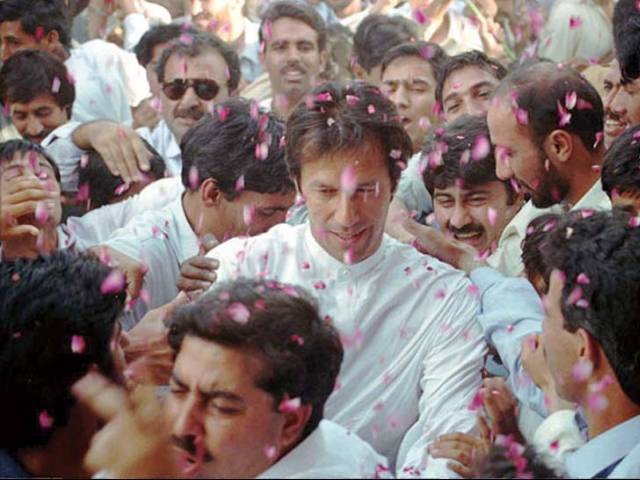
Pakistan’s early problems with democracy
Parliamentary democracy in Pakistan was first introduced in 1970 -- 23 years after Pakistan’s creation in August 1947. Since Pakistan’s first general election based on adult franchise in 1970, the democratic process in the country has been interrupted by two lengthy military regimes and frequent covert inferences by some primary state institutions.
From 1947 till 1958, Pakistan saw the coming and going of seven prime ministers who were all installed by two indirectly elected Constituent Assemblies. In 1956, the country authored its first constitution. The constitution emphasized that Pakistan was to become a parliamentary democracy. But in October 1958, President Iskandar Mirza dismissed the country’s national assembly and seventh prime minister in a military coup executed with the aid of then military chief, Ayub Khan. Twenty days later, Khan ousted Mirza.
According to one of Pakistan’s leading sociologists, late Hamza Alavi, at the time of Pakistan’s creation in 1947, the only established institution that the country inherited was the British-trained army.[1] An underdeveloped country with scarce resources inherited, what Alavi called, ‘an overdeveloped army.’ The military, thus, was the only organized state entity with the ability to resolve issues triggered by political conflicts between underdeveloped civilian bodies.
This greatly politicized the military, especially in a country that was almost immediately impacted by deep ethnic schisms. Pakistan had two wings. West Pakistan was ethnically diverse, having four main ethnic groups – the domineering Punjabi; the Sindhi; the Baloch and the Pashtun -- and the Mohajir community. East Pakistan, on the other hand, had a Bengali majority.
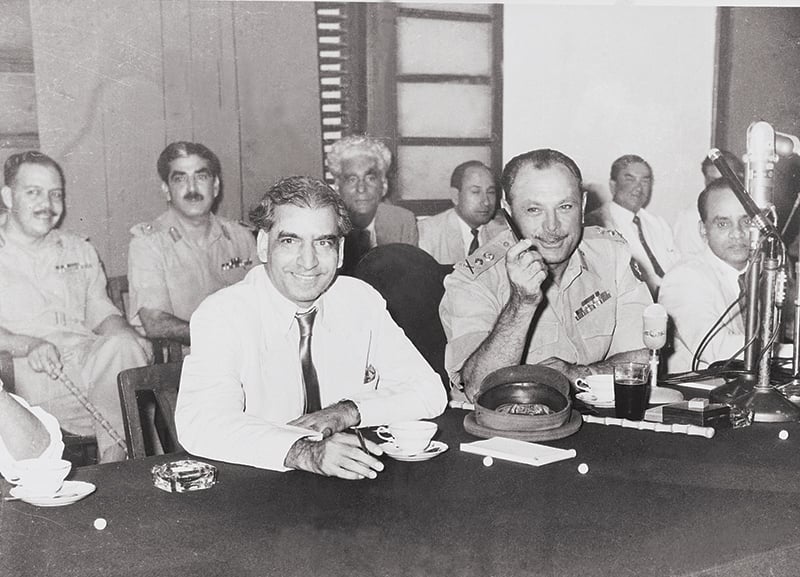
October 1958: Ayub takes over.
Ayub Khan pledged to build a Pakistan which would be empowered by a robust economy, a strong army, and inspired by a modern and progressive Islam. He launched a scathing critique of the concept of parliamentary democracy. He rejected it, claiming that it was not ‘suited to the genius of the people of Pakistan.’[2] As an alternative, he introduced a complicated presidential form of government (‘Basic Democracies’). After being ‘elected’ as president through this system, Ayub promoted himself to Field Marshal.
In 1962 a new constitution was penned which enshrined Ayub’s Presidential form of government as the country’s dominant political system. Riding on the apparent successes of his regime’s economic policies, Ayub was re-elected as president in early 1965. But during the same year, an ill-advised war against India negatively impacted the country’s economy and Ayub’s popularity.
By 1968, the regime was facing a popular protest movement. Ayub was accused of practicing ‘crony capitalism’ and usurping the rights of various ethnic groups. Pushed into a corner by the commotion, Ayub resigned as president in March 1969. He handed over power to then military chief, General Yahya Khan.
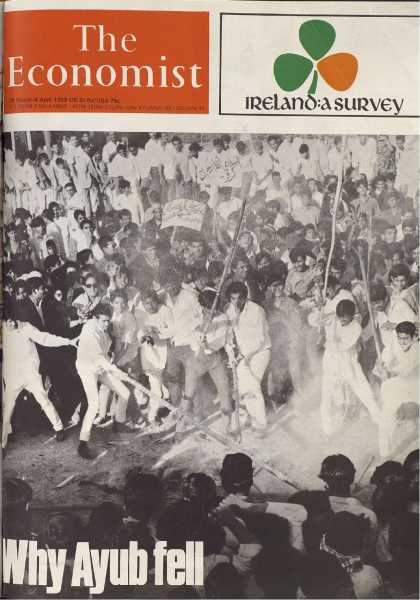
The April 1969 issue of the British monthly, The Economist.
A shock to the system
Compared to the paternal figure of Ayub Khan, General Yahya was a more colorful character. A heavy drinker and a lot happier in the company of beautiful women, Yahya, however, was astute enough to do what was necessary to appease an angry polity.
He agreed to hold the country’s first direct election. But the results of the 1970 election threw up some complicated problems for the ruling and economic elites of West Pakistan. This was mainly due to what the Yahya regime was made to believe by its intelligence agencies. They had predicted a hung parliament.[3] This would have given the military regime the leverage to maneuver things the way it wanted to in the post-election period. Pakistan still had an ‘overdeveloped army’ presiding over a country with weak political institutions.
Sheikh Mujeeb-ur-Rahman’s Bengali nationalist outfit, the Awami League (AL), swept the election in East Pakistan. It was the country’s largest region and had been allotted the most number of national and provincial assembly seats. AL’s sweep in East Pakistan alone made it the majority party. The party lamented that the West Pakistan elite had been usurping East Pakistan’s economic resources.
In West Pakistan, ZA Bhutto’s left-leaning Pakistan People’s Party (PPP) won big in the region’s two largest provinces, the Punjab and Sindh; whereas the left-wing National Awami Party (NAP) – an amalgamation of progressive Baloch, Pashtun and Sindhi nationalists — shared the honors with the religious Jamiat Ulema Islam (JUI) in Balochistan and the North West Frontier Province (NWFP). JUI was the only religious party that did well at the polls. All other religious outfits were routed.
After the initial shock, Yahya regained some equanimity and asked the new national assembly to meet. He was still hopeful of retaining some influence in the new set-up. But the PPP refused to attend the assembly session. It demanded that AL retract its demand for East Pakistan’s provincial autonomy. The PPP that had won the most seats in West Pakistan on a populist socialist manifesto, suddenly found itself on the side of the military-establishment. A delay in handing over the reins of power to AL triggered an outright civil war in East Pakistan.
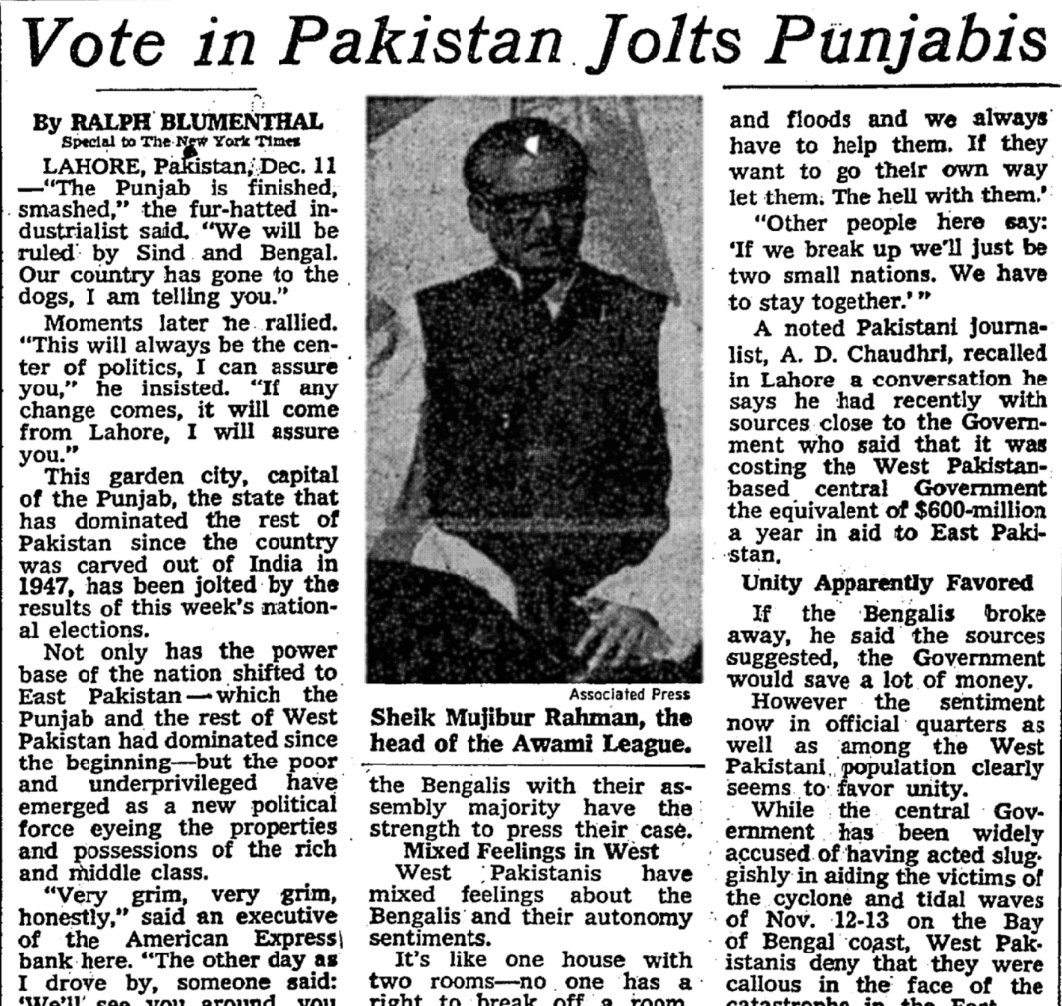
The New York Times’ report on Pakistan’s first parliamentary election.
The deadly commotion drew India into the conflict. This greatly aided the militant Bengali nationalists in defeating the Pakistani state and see East Pakistan secede and become Bangladesh. In December 1971, West Pakistan became the only Pakistan. A group of officers forced Yahya to resign[4] and hand over power to ZA Bhutto and his PPP. In 1973 the national assembly passed a new constitution which declared Pakistan a parliamentary democracy.
Between 1972 and 1974, the Bhutto government’s policies were a direct outcome of the populist socialist promises made in PPP’s manifesto. The second period, 1974-77, saw the regime gradually backtrack and readjust its bearings to the changes in the international arena generated by the 1973 Arab-Israel conflict. As Bhutto navigated Pakistan towards the ever-expanding orbit of oil-rich Saudi and Libyan influence, his regime became increasingly authoritarian.
When the PPP swept the 1977 election, an electoral coalition of religious parties and some center-right anti-Bhutto outfits in the Pakistan National Alliance (PNA) cried foul and accused the regime of rigging the polls. PNA began a protest movement which turned violent. PNA’s manifesto had attacked the Bhutto regime’s ‘socialist policies’ and promised that the alliance, if voted to power, would install nizam-e-mustafa (or a system based on Sharia laws).
Bhutto unleashed the military against the protesters and dozens of protesters were killed. But he was forced to begin talks with PNA leaders when some military officers in Lahore refused orders to fire on a group of protesters.[5] Bhutto agreed to investigate the alliance’s allegations of rigging and also to close down bars and nightclubs and ban the sale of alcoholic beverages to Muslims.
The military, now under the conservative military general, Zia ul-Haq, who was handpicked by the prime minister in 1976, watched closely from the sidelines how Islamic slogans had galvanized a large number of people to challenge the authority of a powerful prime minister.
In this, Zia saw a way to use the ‘Islamic card’ to repair the credibility of the military and revive the political influence the institution had lost after the 1971 East Pakistan debacle. Using the turmoil created by the PNA movement as a pretext, Zia toppled the Bhutto regime in a coup and imposed the country’s third martial law. In his first address, he promised to turn Pakistan into a ‘true Islamic state.’
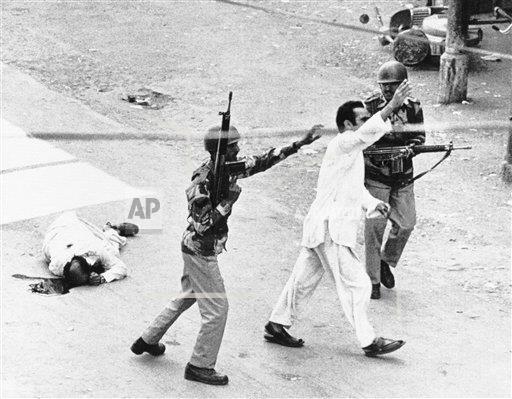
Soldiers arrest a PNA activist during the anti-Bhutto riots of March 1977. A man can also be seen laying on the road, bleeding.
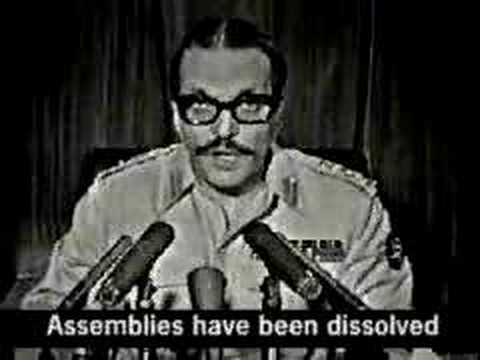
July 1977: Zia takes over. He claimed there was political chaos in the country and from now on only ‘pious’ people (later termed as ‘Sadiq and Amin’) would be allowed to take part in politics.
Square one
In 1979, two years after imposing the country’s third military regime, and just months before sending Bhutto to the gallows on a dubious charge of ordering the murder of a political opponent, General Zia unfolded the 1979 Hudood Ordinances. The Ordinances contained a set of laws intended to introduce Sharia rule in the country. The same year in October, Zia stressed that ‘in Islam there was no provision for Western-type elections.[6]
After the December 1979 Soviet invasion of Afghanistan, the Zia dictatorship was bolstered by massive US and Saudi aid. In 1984, Zia got himself elected as president through a sham referendum.[7] In 1985, he announced the holding of elections but without the participation of political parties.
Consequently Zia managed to formulate a national assembly packed with his supporters. The same year he succeeded in unifying the many factions of the country’s founding party, the Muslim League and dubbed it Pakistan Muslim League (PML). But this League was different from Pakistan’s founder Muhammad Ali Jinnah’s quasi-secular Muslim League and Ayub Khan’s ‘modernist’ Convention Muslim League. The new League became the civilian expression of Zia’s ‘Islamization program.’
In 1987, accusing his own handpicked Prime Minister, Muhammad Khan Junejo, of undermining the Islamization process, Zia dismissed the government and dissolved the assemblies. He announced fresh elections, but again on ‘party-less basis.’ However, in August 1988, the dictator died in a plane crash. He was replaced by the chairman of the senate, Ghulam Ishaq Khan, who immediately announced an election in which all political parties were allowed to participate.
Democracy returned to Pakistan in November 1988. There were four elections held between 1988 and 1997. This was a volatile period in which two pro-establishment presidents dismissed two PPP and one PML-N governments on charges of ‘corruption.’
This period was followed by a military coup in 1999, but one which held a party-based election in 2002. The military, which had regained its political leverage during the Zia dictatorship, was instrumental in influencing policy during all democratic set-ups.
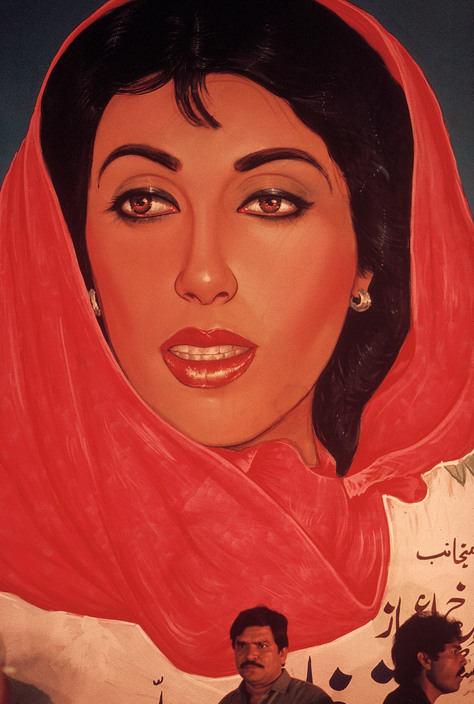
Democracy returns: A huge hoarding of Benazir Bhutto in Faisalabad during the 1988 election.
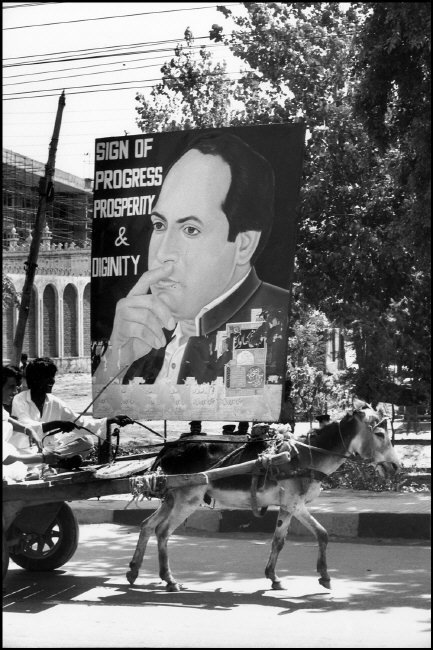
Nawaz Sharif broke away from PML in 1993 and formed his own PML faction, the PML-N.

In late 1999, accusing political parties of corruption, Gen Pervez Musharraf installed the country’s fourth military regime.
The 2018 election
The 2018 election was the third after the last military ruler, General Pervez Musharraf, was forced to resign in early 2008. The center-right party, the Pakistan Tehreek-e-Insaf (PTI) headed by the former Pakistan cricket captain, Imran Khan, bagged the largest number of seats. It won 116 national assembly (NA) seats out of a total of 272. However, he failed to even win a simple majority and had to form a coalition government with various smaller parties and ‘independent’ candidates.
The centrist Pakistan Muslim League-Nawaz (PMLN) that had swept the 2013 election with 126 seats, came second with 64 NA seats. The center-left Pakistan People’s Party (PPP) grabbed 43, ten more than its tally of 33 in 2013.
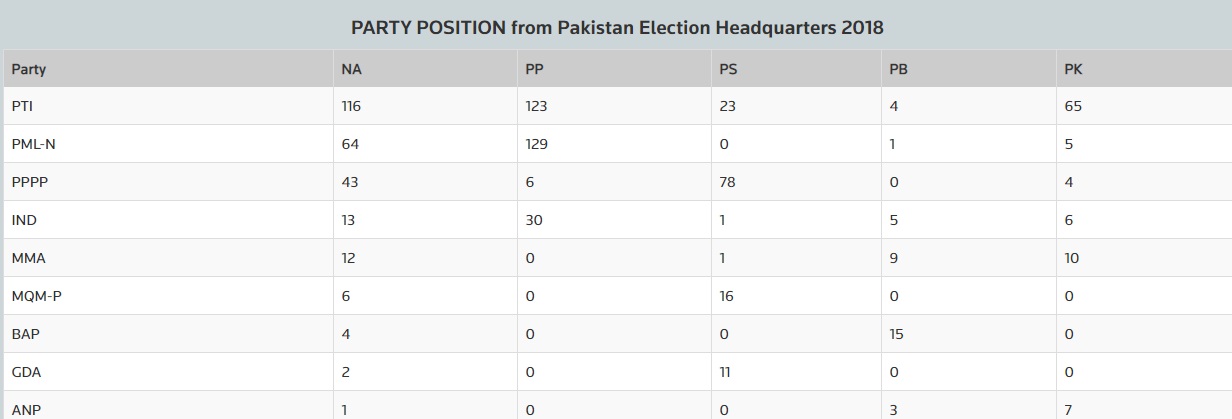
The 2018 NA and PA election results.
Almost all parties, except the PTI, alleged that the elections were rigged in favor of the PTI. They alleged that the military-establishment, the higher judiciary and the Election Commission of Pakistan (ECP) worked in tandem ‘to assure a PTI win.[8]
Indeed, some glaring irregularities in this context did come to light, but the results were not that far off from the ones predicted by almost all major opinion polls held in the months leading up to the elections. Most of these polls had predicted a neck-to-neck contest between PML-N and PTI. That’s why some observers believe that it was not PTI’s victory that made the election seem controversial, but the possibility that the party might have been ‘gifted’ an extra 10 to 15 seats in addition to the 90 to 95 it was predicted to win.

Most opinion polls predicted a neck-to-neck competition between PML-N and PTI.
The PTI was formed by Imran Khan in 1995-96. He had enjoyed a life of a celebrity sportsman and ‘playboy’[9] before retiring from cricket in 1992. After retirement, he went through a spiritual transformation of sorts, becoming a ‘born-again Muslim.’ PTI did not gain any mentionable momentum till 2011, but Khan was able to turn himself into a political brand through regular appearances on TV talk shows and his tirades against corruption.
Khyber Pakhtunkhwa
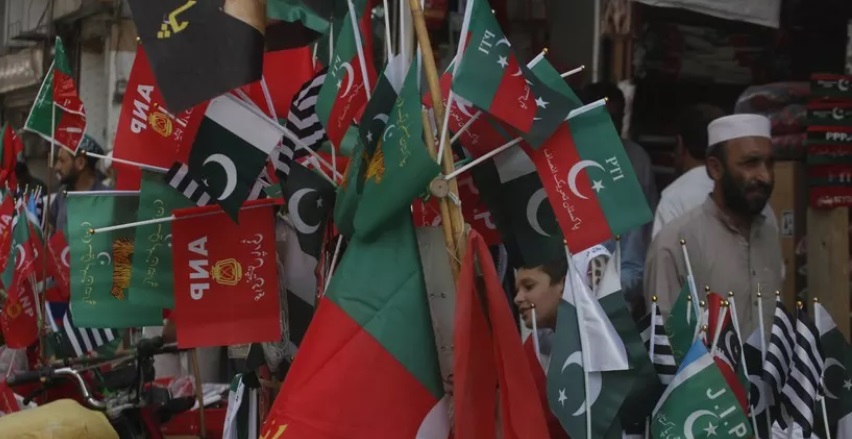
In 2013, the PTI had won just 27 NA seats. The bulk of them were won in the Pashtun-majority province, the Khyber Pakhtunkhwa (KP). PTI, which had been able to form a provincial government in KP in 2013, swept KP in 2018, winning 67 of KP’s 99 provincial assembly (PA) seats and majority of the province’s NA seats.
KP is seen as an electorally fickle province. It was dominated by the left-wing National Awami Party (NAP) and the right-wing Jamiat Ulema Islam (JUI) during the 1970 election. Then, between 1988 and 1997, it bounced between the PPP, PMLN and the Pashtun nationalist outfit, the Awami National Party (ANP).
In the 2002 election, held during the General Musharraf dictatorship and shortly after the US attack on then Taliban-ruled Afghanistan, KP largely voted for an alliance of right-wing religious parties, the Muttahida Majlis-e-Amal (MMA) which managed to form a provincial government here.
Bordering Afghanistan, KP had already been impacted by the Afghan Civil Wars of the 1980s and 1990s and the rise of Taliban in 1996. Despite having an Islamist provincial government, KP faced the brunt of the terror attacks perpetrated by Al-Qaeda (AQ) cells in Pakistan between 2004 and 2006. In 2007, as the Musharraf regime was able to somewhat curb AQ activities in the country, an amalgamation of militant Islamist and Sunni sectarian groups formed the Tehreek-e-Taliban Pakistan (TTP). It was headquartered in Pakistan’s rugged tribal areas which lay between KP and Afghanistan.
Ravaged by AQ and TTP attacks on civilian and security targets, the electorate in KP voted out the MMA in the 2008 election, and voted-in the secular ANP. ANP managed to form the next provincial government here. But attacks by the TTP in KP witnessed a manifold increase. Numerous ANP leaders were assassinated by the TTP before KP voters switched again and voted for the PTI in 2013.
Two main factors contributed the most in helping PTI sweep KP in 2018. TTP attacks greatly reduced during PTI’s provincial government here between 2013 and 2018. The irony is that the decrease in TTP terror attacks was achieved by an unprecedented military operation that the PTI had actually opposed.
The operation, started in 2014, was initiated by then Army chief, General Raheel Sharif, who persuaded the PML-N government and the parliament to green-light a widespread military operation against the TTP. PTI chairman, Imran Khan, had maintained that ‘Pakistan was fighting America’s war’[10] and that peace could be brokered with the TTP through negotiations.
So the PTI regime in KP became one of the main beneficiaries of a military operation that it had originally opposed. The second major factor that helped PTI retain voter preference in KP was the police reforms that the PTI provincial government had initiated in the province. These effectively depoliticized recruitment in KP’s police department, improving its performance.[11]
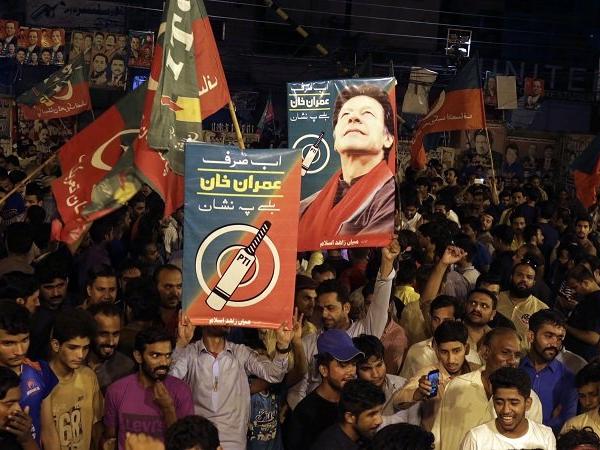
PTI swept the 2018 election in KP.
The MMA that had disbanded after its loss in 2008, regrouped in 2018 and was expected to give PTI a tough fight in KP’s more conservative constituencies. But it too was swept aside by the PTI wave in the province. In early 2018, the PTI government in KP had ‘donated’ millions of rupees to a seminary run by the intransigent Deobandi-Sunni cleric, Sami ul-Haq.[12] This gesture, undertaken in the name of ‘madrassa reform,’ was able to help PTI usurp the JUI and JI vote-banks in KP.
Sindh

The country’s southern-most province, Sindh, on the other hand was swept by the PPP. The center-left party has won five national elections since 1970, but ever since 1988, its national vote-bank has been gradually decreasing.
However, it has remained intact in the Sindhi-majority areas of the Sindh province. Only thrice has the PPP failed to form a provincial government in Sindh in the ten elections held in the country since 1970. In 2018, the PPP once again won the bulk of Sindh’s NA seats and 74 of the province’s 130 PA seats. But as always, the situation in Sindh’s (and Pakistan’s) largest city, Karachi, was entirely different.
Karachi is the country’s most ethnically diverse city. Unlike Sindh’s other cities, Karachi does not have a Sindhi-speaking majority. The Urdu-speaking Mohajirs are the largest ‘ethnic’ community in the city,[13] followed by the Pashtun, the Punjabi/Siraiki, Baloch and Sindhis.[14]
Between 1970 and 1988, Karachi’s Mohajir majority had largely voted for mainstream religious parties such as the JI and the Barelvi-Sunni Jamiat Ulema Pakistan (JUP). Yet, Karachi was and is still considered to be Pakistan’s most ‘liberal’ and ‘secular’ city.[15]
This dichotomy was often explained by analysts by describing the Mohajirs as being socially liberal but politically conservative.[16] The Mohajirs, or Urdu-speaking Muslims who migrated from India to Pakistan in 1947, did not have a natural constituency in Pakistan. Unlike the Bengalis, Sindhi, Pashtun, Punjabi and Baloch, the Mohajirs were not ‘people of the soil.’
As ethnic schisms appeared early on in the country, the Mohajirs felt insecure, believing that most political parties in the country were dominated by one ethnic group or the other. The Mohajirs’ proclivity towards the religious parties was almost entirely based on the perception that these parties had stood for non-ethnic Islamic universalism.
In 1986 when deadly riots broke out between Karachi’s Pashtuns and the Mohajirs, former student leader, Altaf Hussain, launched the Mohajir Qaumi Movement (MQM). He described the Mohajirs as a distinct ethic group. MQM’s ideologues also began to express the Mohajirs’ new political disposition through the community’s inherent social liberalism. MQM became one of the most overtly secular parties in the country.
The party almost immediately struck a chord with Sindh’s Mohajirs. It won every election in Karachi between 1988 and 2013. This, despite the fact that the state launched at least three military and police operations against what were described as the party’s ‘militant wings.’
But from 2015 onwards, the party began to disintegrate, due to severe in-fighting. In 2017 it broke into three factions, the largest being MQM-Pakistan (MQM-P).
In 2018, MQM faced its first defeat in Karachi ever since the party’s inception. Out of Karachi’s 21 NA seats, PTI won 13, and 21 PA seats. The remaining went to MQM-P, PPP and the Tehreek-e-Labaik-Pakistan (TLP). The PPP faced a major upset in its Karachi stronghold of Lyari — one of the largest working-class and impoverished areas of the city, mostly populated by Baloch and Katchi speakers. Before 2018, PPP hadn’t lost an election here since 1970.
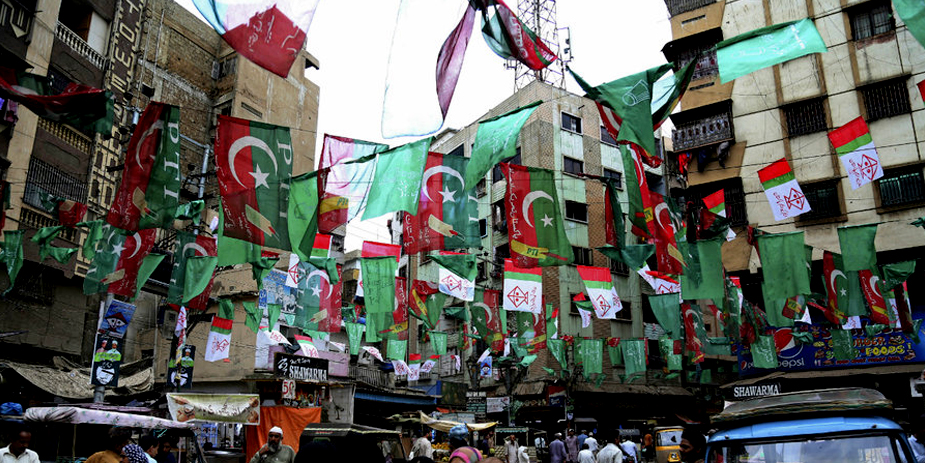
In 2018 PTI handed MQM its first major defeat in Karachi. The MQM had not lost an election in the city since 1988.
The new entrant TLP surprised everyone when it managed to bag 2 PA seats in Karachi. TLP was formed in 2016 by groups of radical Barelvi-Sunni Muslim clerics. The outfit materialized in the Punjab as a reaction to the execution of Mumtaz Qadr -- the man, who, in 2011, had gunned down former Governor of Punjab, Salmaan Taseer, after accusing him of committing blasphemy. Majority of Pakistani Sunni Muslims are Barelvi.
The Barelvi Sunni sub-sect emerged in South Asia in the late 19th century. It is a fusion of the esoteric Sufism which evolved in India from the 13th century and the many rituals and customs that the Muslims of the region adopted from the pre-Islamic faiths existing in South Asia.
It is thus a more populist strand of South Asian Islam compared to the region’s other Sunni strands, such as the Deobandi and the Ahl-e-Hadith. Historically, the Barelvi and the Deobandi have been antagonistic towards each other. The Barelvi are also hostile towards external Sunni sub-sects such as the Ahl-e-Hadith.
But the Barelvi have never been an organized lot. The JUP used to be the largest Barelvi religious party, but by the 1990s, it had splintered. The Barelvi do not have a jihadist doctrine or tradition.[17] Their radicalism mainly stemmed from what they believed was Saudi Arabia’s funding of radical Deobandi and Ahl-e-Hadith groups in the 1980s.
In 2009, the United States funded the time’s largest Barelvi group in Pakistan, the Sunni Ittihad Council,[18] which was opposing the TTP. However, what was missed by the US was the fact that, indeed, the Barelvi were opposed to the TTP, but the radical Barelvi see themselves as the protectors of Pakistan’s controversial blasphemy laws (enacted by Zia).
The TLP is the most radical Barelvi outfit to emerge in Pakistan. During the 2018 election it received the sixth largest number of votes across the country. Much of its following comes from the lower-middle-class segments in the cities and towns of Punjab and Karachi.
Analysts believe the votes that TLP received in these areas were largely protest votes, because TLP’s charismatic and somewhat eccentric cleric-leader, Khadim H. Rizvi, does not offer much other than colorful tirades against those who want to undo or even reform the country’s blasphemy laws.
In Karachi, for example, many lower-middle-class Mohajirs who are mostly Barelvi, voted for the TLP to register their disgruntlement against the disoriented and squabbling leadership of the MQM.
TLP also won a PA seat in Lyari. Here many Baloch and Katchi voters cast their votes for TLP as a reaction to the PPP provincial government’s mishandling of the street gang wars that decimated the area between 2008 and 2014. PTI too won seats from Lyari.
In Karachi, TLP mainly attracted the lower-middle-class Mohajir votes. This opened up the traditional MQM vote-bank with much of it tilting towards PTI and TLP. MQM-P could bag just 6 NA seats in Sindh.
Just as they had done in 2013, bulk of Karachi’s middle and upper-middle class votes were again cast for PTI. More than Khan’s allusions to Islam, it is his impassioned stands against corruption which attracted voters from these classes. They can be explained as a blocked elite that enjoys considerable economic influence but believes its entry into politics is being blocked by the PPP and PML-N.
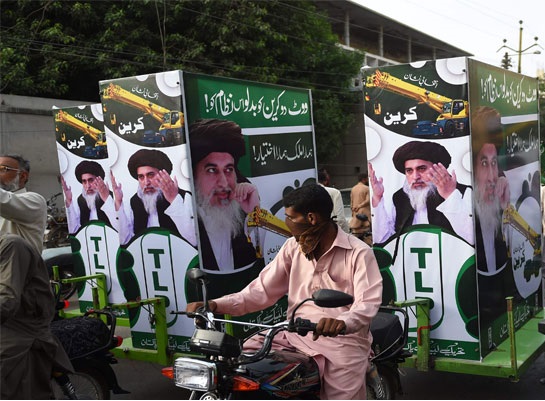
The radical Barelvi outfit, the TLP, usurped chunks of lower-middle-class Mohajir and Katchi-speaking votes in Karachi.
Sindh beyond Karachi and parts of Hyderabad, was taken whole by the PPP. An electoral alliance of some conservative Sindh-based parties and Sindhi nationalist groups, the Grand Democratic Alliance (GDA), failed to dent the solid PPP vote bank here.
For decades the Sindhis outside Karachi have come to know and trust the PPP as the party that has become a bridge which helps them get access to the benefits of national-level politics and economics. PTI invested a lot of effort in northern Sindh by co-opting some heavyweight anti-PPP politicians, but they were defeated. PTI could not make any inroads in the province outside of Karachi. Another reason for this is the fact that most Sindhis perceive the PTI as a Punjab-centric party, just as they do the PML-N.

Outside Karachi, the PPP once again swept the election in Sindh.
Punjab
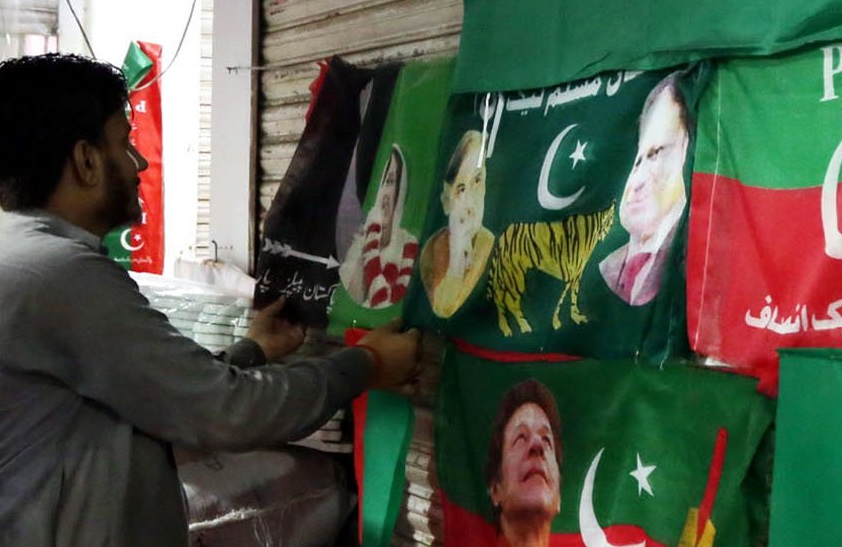
Much of PTI’s electoral efforts went into winning big in the Punjab. Being Pakistan’s largest and most populated province, it has the largest number of NA and PA seats. If a party is able to sweep Punjab, it can form a national government even without doing so well in other provinces.
Between 1970 and 1988, Punjab had been an electoral bastion of the PPP that had swept it in 1970 and 1977. Even though the party again won here in 1988, the percentage of its votes in the province fell from being 41.7% in 1970 and a whopping 61.7% in 1977 to 39.4% in 1988. During the 1997 election, the percentage plummeted to 22.2%.
In 1985 when Zia reengineered the PML, his dictatorship distributed large amounts of money among the NA and PA members of the PML. The money was handed over in the name of ‘development funds.’ Punjab was flush with such funds which not only accelerated the growth of a new middle and trader class here, but brought forth a new generation of conservative but enterprising politicians in the province.
Secondly, PML when it became part of a right-wing anti-PPP alliance in 1988, denounced the PPP as a Sindhi party. During the 1988 and 1990 elections, PML used the slogan ‘Jaag Punjabi jaag’ (wake up, Punjabis) to suggest that a Sindhi party was undermining the interests of the Punjabis.
PML broke into three factions in 1993. The largest of these was Nawaz Sharif’s PML-N. But like PML, this faction too remained pro-establishment, and continued to pander to the province’s new middle, trader and lower-middle-classes that had emerged in the 1980s.
However, in 1997, even though PML-N’s vote bank in Punjab continued to climb, Nawaz, during his second term as PM, decided to break away from the establishment’s orbit. This saw him being toppled in a military coup in 1999.
From 2008 onward, PMLN’s ideological orientation gradually began to move more towards the centre. This helped the party to limit the sympathy wave the PPP experienced after the assassination of Benazir Bhutto in 2007.
But as PML-N continued to move towards the centre, and the PPP’s vote-bank in the Punjab crashed to just 10.2% in 2013, PTI began to manoeuvre itself as an alternative by adopting some erstwhile populist positions of the old PPP and the Islamist rhetoric of the PML-N of the 1990s.
In the Punjab PTI basically filled the vacuum created by PML-N’s gradual ideological shift. For example, it was during the recently concluded PML-N government that Mumtaz Qadri was hanged. PTI had remained quiet on the execution, and this, in turn, saw PML-N’s religious Barelvi voters opting to vote for TLP in 2018.
This indirectly aided PTI to defeat PML-N in various constituencies of the province. Nevertheless, PML-N still managed to win more seats here than the PTI. It won 129 PA seats in the Punjab compared to PTI’s 123. But with smaller parties, PTI has managed to form albeit shaky provincial government in the province.
Tensions between PML-N and PTI supporters continue to intensify, especially in North and central Punjab regions which, ever since 1997, have largely voted for centre-right parties. The perception that PML-N had clashed with the military-establishment, lost the party votes in these regions where voters closely identify with the military. Central Punjab on the other hand remained firmly with PML-N, whereas the more impoverished Southern Punjab that had largely voted for the PPP in the 1990s, before switching to PML-N in 2013, now turned towards PTI.
Balochistan
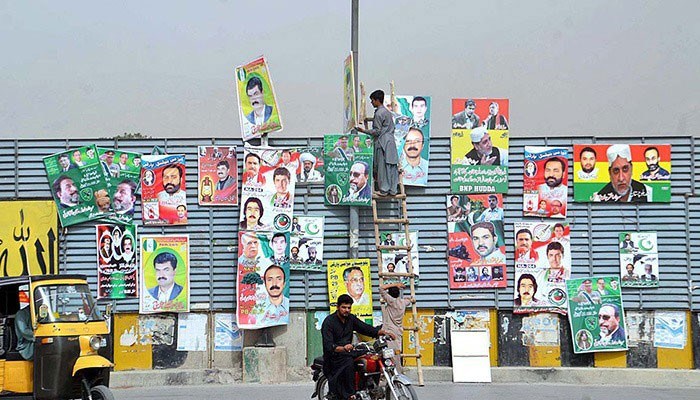
The election in the country’s rugged and arid province of Balochistan threw up a surprise when a pro-establishment Baloch party, the Balochistan Awami Party (BAP) won the most seats here. The left-wing NAP had swept the elections here in 1970. But the provincial government that the party formed was dismissed by ZA Bhutto whose regime accused NAP of aiding Baloch separatists.
The province witnessed an armed Baloch uprising till 1977. Balochistan has two main ethnic groups, the Baloch and the Pashtun. During the post-1988 elections, the Baloch have largely voted for various Baloch nationalist parties, whereas the Pashtuns have either voted for the two Pashtun nationalist outfits, the ANP and the Pakhtunkhwa Awami Party (PkAP), or the Deobandi JUI. PML-N and PPP also have vote banks here.
The province has witnessed a lot of violence recently, mainly due to attacks on Shia Muslims by extremist Sunni outfits and attacks on Punjabis and security forces by militant Baloch nationalist organisations.
BAP offered a way out by fusing watered-down Baloch and Pashtun nationalist sentiments with overt Pakistani nationalism. BAP agreed to become a coalition partner of the new PTI government in the centre.
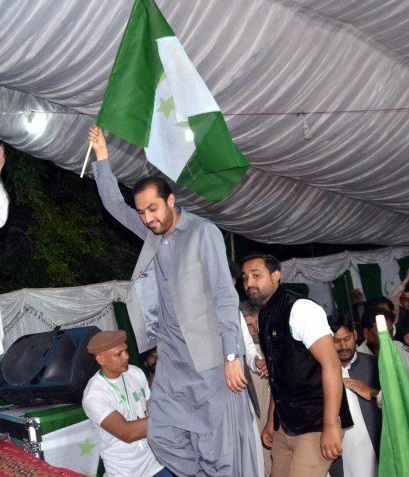
The newly-formed BAP won big in Balochistan.
The Minorities
Even though no detailed findings have come to light about who Pakistan’s religious minority groups voted for in 2018, but some newspaper reports did allude that the Hindus of Sindh largely voted for the PPP, whereas the Hindus and Christians of Karachi mostly voted for the PTI.
In Karachi, the Hindus and the Christians had been MQM voters ever since the controversial system of separate electorates (introduced by Zia) was done away with by Musharraf in 2002. In the rest of Sindh the Hindus seemed to have overwhelmingly voted for the PPP.
In the Punjab, the region’s large Christian minority vote seemed to have been split between PML-N and PTI. But many leaders of the Christian community are on record to lament that both the parties have offered little to curb attacks on Christians by radical Muslim groups and clerics.
The results of the 2018 election are a daunting reflection of a society that remains to be severely polarised on various political, economic and religious issues.
[1] Hamza Alavi: The State in Post-Colonial Societies, New Left Review (July/August 1972) p.74
[2] A M. Ahmada: End of a Betrayal and Restoration of Lahore Resolution (Khosroz Kitab Mahal, 1975) p.303
[3] Feroz Khan: Eating Grass: Making of the Pakistani Bomb (Stanford University Press, 2012) p.74
[4] R Sisson, LE Rose: War and Succession: Pakistan, India and the Creation of Bangladesh (University of California Press, 1991) p.235
[5] What Goes Around: The Movement Against Bhutto, DAWN (August 31, 2014)
[6] Pakistan 1979: Back to Square One: WL Richter; WE Gustafson (Survey of Asia Vol:20, February 1980) p.192
[7] Ian Talbot: Pakistan: a Modern History (St. Martin’s Press, 1998) p.261
[8] PMLN Joined Assemblies to Protest Against Rigging, Manipulation Against Election 2018, The News (August 15, 2018)
[9] Imran Khan’s Playboy Image Was Forged In England, The Times (July 28, 2018)
[10] Imran Khan’s interview with ARY News (February 4, 2018)
[11] PTI set to replicate police reforms in Punjab, The Nation, (August 12, 2018)
[12] Imran defends funding for Sami’s madrassa, Daily Times (February 25, 2018)
[13] Karachi Population. (2017-10-17). Retrieved 2018-09-18, from http://worldpopulationreview.com/world-cities/karachi/
[14] Khaled Ahmad: The Pakhtun In Karachi, The Express Tribune (August 28, 2010)
[15] S. Inskeep: Instant City: Life and Death in Karachi (Penguin Books, 2012) p.284
[16] S Shafqat: MQM as Liberal Savior of Karachi, Asian Survey (September/October, 2017)
[17] Mujeeb Ahmad: Dawat-e-Islami: A Revivalist Movement of Barelvis, Journal of South Asian & Middle Eastern Studies (Winter, 2011)
[18] US aid to SIC backfires, Express Tribune (January 12, 2012)
